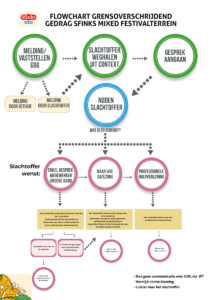At Sfinks we welcome everyone and we like to make it a warm party. This only works if we treat each other with respect. Some Sfinks employees followed a training course at Pimento/Sensoa about transgressive behaviour. They are recognizable and your first point of contact. You can also always visit the safe zone.
WHAT IS TB?
(Sexual) transgressive behavior is a social problem. Many people are witnesses but do not know how to intervene. Responding makes all the difference: the behavior cannot escalate further, it stops and the victim is helped.
When do we talk about GOG? This is different for everyone. It is important to respect people’s boundaries.
- YOU ARE BYSTANDER
-
- Observe: You see or hear a situation happen
- Recognize: You estimate the situation as transgressive
- Taking responsibility: You realize that you as a bystander can have an effect on the situation by intervening
- React: You seek a response that suits you and the situation, without putting yourself in danger.
- BYSTANDING EFFECT
The bystander effect is the failure of bystanders to provide assistance in an emergency or crime. For example, people watch passively or look away and take action very late in the event of transgressive behaviour.
The theory is: the larger the group of bystanders, the smaller the chance that someone will intervene.
- VICTIM BLAMING
When there is question of transgressive behavior, various reasons are often indicated as ’cause’ (clothing, time, environment, behavior…) but the only real cause is the perpetrator who commits the transgressive behaviour.
Victim blaming is often a self-defense response:
“That wouldn’t happen to me because…” This gives us a (unjustified) sense of security, but it is very harmful and can be traumatizing for the victim.
- RESPOND: 5 A’S (van Sensoa)
-
- Involve others: Involve bystanders
- Approach: is everything okay with you (victim)?
- Create a distraction: Have a chat with the victim, attract attention
- Isolate: try to separate the people involved
- Stay present: don’t know how to respond? Stay present and keep an eye on the situation
- SENSITISING IMAGE SFINKS


